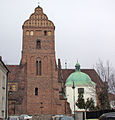New Town, Warsaw


The Warsaw New Town is a neighbourhood dating from the 15th century in Warsaw, Poland. It lies just north of the Old Town and is connected to it by ulica Freta (English: Freta Street), which begins at the Warsaw Barbican. Like the Old Town, the New Town was almost completely destroyed by the Germans during World War II and rebuilt after the war.
History
The historic district of the New Town was formed at the turn of the 14th century as an independent city.[1] The official recognition of the New Town occurred in 1408, when it was separated from the Old Town by an act issued by Janusz I the Old, Duke of Masovia.[2] At that time the new city encompassed the territory of the New Town Market Square and streets - Freta, Kościelna, Koźla, Przyrynek, Stara and Zakroczymska. It was independent from the Old Town authorities and had its own vogt, council and a town hall. In 1411 the Parish Church of St. Mary was erected, and according to the 1546 mensuration there were 204 estates in the Warsaw New Town. The largest investment of that time was the Sigismund Augustus bridge built between 1568-1573 by Erazm Cziotko (c. 500 m (1,600 ft) long).[3] Unfortunately it was destroyed in 1603 by the drifting ice floes.

The disastrous time of the Swedish-Brandenburgian invasion (1655–1660), left the predominantly timber buildings of the New Town burned, but because of those events many beautiful and more permanent buildings were erected (the Town Hall, built in 1680; St. Kazimierz Church, 1688–1692; the Kotowski Palace, 1682–1684; the Holy Spirit Church, 1707–1717; and the ornate chapel of the Kotowski family, constructed between 1691-1694) by the most prominent Warsaw architects (especially Tylman Gamerski).[2] After 1791, due to the tenets of the Constitution of May 3, 1791, the New Town was incorporated into the city of Warsaw. That is why the Town Hall was pulled down in 1818.
During the Warsaw Uprising (1 August – 2 October 1944) the New Town was completely destroyed due to the extensive bombardment of the insurgent positions by the Germans.[2][4] Many historic edifices, that served as hospitals and shelters for the inhabitants were razed to the ground.[2][4] The reconstruction of the New Town started in 1954, but some of the significant buildings were not restored by the Communist authorities (e.g. Kotowski Palace).[5]
See also
References
- ^ "The New Town". www.um.warszawa.pl. Retrieved 2010-01-26.
- ^ a b c d Neil Wilson; Tom Parkinson; Richard Watkins (2005). Poland. Lonely Planet. p. 67. ISBN 1-74059-522-X.
{{cite book}}: Cite has empty unknown parameter:|chapterurl=(help) - ^ Jerzy S. Majewski (2004-04-29). "Most Zygmunta Augusta". miasta.gazeta.pl (in Polish). Retrieved 2009-10-25.
- ^ a b Joanna K. M. Hanson (2004). The Civilian Population and the Warsaw Uprising of 1944. Cambridge University Press. p. 99. ISBN 0-521-53119-5.
{{cite book}}: Cite has empty unknown parameter:|chapterurl=(help) - ^ "Zespół kościelno-klasztorny Sakramentek na Rynku Nowego Miasta". www.varsovia.pl (in Polish). Retrieved 2008-07-09.
Gallery
Historical images
-
The New Town by Bernardo Bellotto
-
The Nowe Miasto Town Hall in 1784
-
The New Town by Jan Piotr Norblin
Churches
-
St. Mary's Church, 1411
-
St. Hyacinth's Church, 1603-1639
-
St. Benno Church, 1669
-
St. Kazimierz Church, 1688-1692
-
Holy Spirit Church, 1717
-
St. Francis Church, 1733
Others
-
Old Bridge Gate, 1582
-
Sapieha Palace, 1731-36
-
Sierakowski Palace, 1784
-
Raczyński Palace, 1786
-
The historical center of Warsaw















